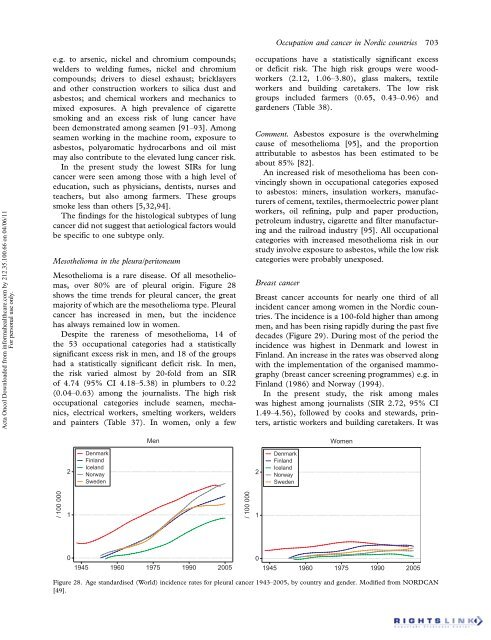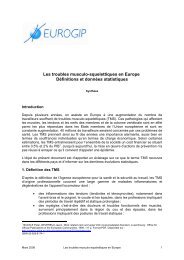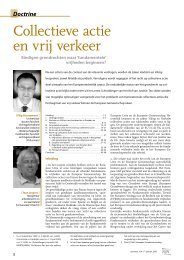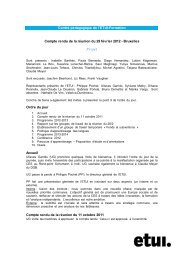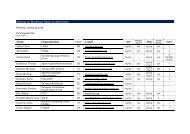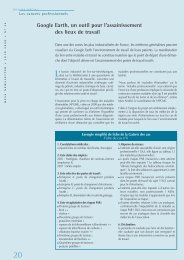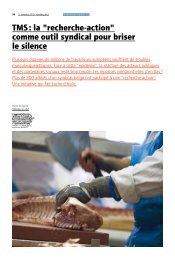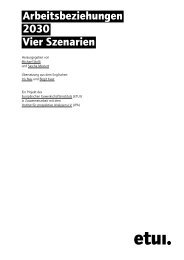Occupation and cancer - European Trade Union Institute (ETUI)
Occupation and cancer - European Trade Union Institute (ETUI)
Occupation and cancer - European Trade Union Institute (ETUI)
Create successful ePaper yourself
Turn your PDF publications into a flip-book with our unique Google optimized e-Paper software.
Acta Oncol Downloaded from informahealthcare.com by 212.35.100.66 on 04/06/11<br />
For personal use only.<br />
e.g. to arsenic, nickel <strong>and</strong> chromium compounds;<br />
welders to welding fumes, nickel <strong>and</strong> chromium<br />
compounds; drivers to diesel exhaust; bricklayers<br />
<strong>and</strong> other construction workers to silica dust <strong>and</strong><br />
asbestos; <strong>and</strong> chemical workers <strong>and</strong> mechanics to<br />
mixed exposures. A high prevalence of cigarette<br />
smoking <strong>and</strong> an excess risk of lung <strong>cancer</strong> have<br />
been demonstrated among seamen [91 93]. Among<br />
seamen working in the machine room, exposure to<br />
asbestos, polyaromatic hydrocarbons <strong>and</strong> oil mist<br />
may also contribute to the elevated lung <strong>cancer</strong> risk.<br />
In the present study the lowest SIRs for lung<br />
<strong>cancer</strong> were seen among those with a high level of<br />
education, such as physicians, dentists, nurses <strong>and</strong><br />
teachers, but also among farmers. These groups<br />
smoke less than others [5,32,94].<br />
The findings for the histological subtypes of lung<br />
<strong>cancer</strong> did not suggest that aetiological factors would<br />
be specific to one subtype only.<br />
Mesothelioma in the pleura/peritoneum<br />
Mesothelioma is a rare disease. Of all mesotheliomas,<br />
over 80% are of pleural origin. Figure 28<br />
shows the time trends for pleural <strong>cancer</strong>, the great<br />
majority of which are the mesothelioma type. Pleural<br />
<strong>cancer</strong> has increased in men, but the incidence<br />
has always remained low in women.<br />
Despite the rareness of mesothelioma, 14 of<br />
the 53 occupational categories had a statistically<br />
significant excess risk in men, <strong>and</strong> 18 of the groups<br />
had a statistically significant deficit risk. In men,<br />
the risk varied almost by 20-fold from an SIR<br />
of 4.74 (95% CI 4.18 5.38) in plumbers to 0.22<br />
(0.04 0.63) among the journalists. The high risk<br />
occupational categories include seamen, mechanics,<br />
electrical workers, smelting workers, welders<br />
<strong>and</strong> painters (Table 37). In women, only a few<br />
/ 100 000<br />
2<br />
1<br />
Denmark<br />
Finl<strong>and</strong><br />
Icel<strong>and</strong><br />
Norway<br />
Sweden<br />
Men<br />
0<br />
1945 1960 1975 1990 2005<br />
/ 100 000<br />
occupations have a statistically significant excess<br />
or deficit risk. The high risk groups were woodworkers<br />
(2.12, 1.06 3.80), glass makers, textile<br />
workers <strong>and</strong> building caretakers. The low risk<br />
groups included farmers (0.65, 0.43 0.96) <strong>and</strong><br />
gardeners (Table 38).<br />
Comment. Asbestos exposure is the overwhelming<br />
cause of mesothelioma [95], <strong>and</strong> the proportion<br />
attributable to asbestos has been estimated to be<br />
about 85% [82].<br />
An increased risk of mesothelioma has been convincingly<br />
shown in occupational categories exposed<br />
to asbestos: miners, insulation workers, manufacturers<br />
of cement, textiles, thermoelectric power plant<br />
workers, oil refining, pulp <strong>and</strong> paper production,<br />
petroleum industry, cigarette <strong>and</strong> filter manufacturing<br />
<strong>and</strong> the railroad industry [95]. All occupational<br />
categories with increased mesothelioma risk in our<br />
study involve exposure to asbestos, while the low risk<br />
categories were probably unexposed.<br />
Breast <strong>cancer</strong><br />
Breast <strong>cancer</strong> accounts for nearly one third of all<br />
incident <strong>cancer</strong> among women in the Nordic countries.<br />
The incidence is a 100-fold higher than among<br />
men, <strong>and</strong> has been rising rapidly during the past five<br />
decades (Figure 29). During most of the period the<br />
incidence was highest in Denmark <strong>and</strong> lowest in<br />
Finl<strong>and</strong>. An increase in the rates was observed along<br />
with the implementation of the organised mammography<br />
(breast <strong>cancer</strong> screening programmes) e.g. in<br />
Finl<strong>and</strong> (1986) <strong>and</strong> Norway (1994).<br />
In the present study, the risk among males<br />
was highest among journalists (SIR 2.72, 95% CI<br />
1.49 4.56), followed by cooks <strong>and</strong> stewards, printers,<br />
artistic workers <strong>and</strong> building caretakers. It was<br />
2<br />
1<br />
<strong>Occupation</strong> <strong>and</strong> <strong>cancer</strong> in Nordic countries 703<br />
Denmark<br />
Finl<strong>and</strong><br />
Icel<strong>and</strong><br />
Norway<br />
Sweden<br />
Women<br />
0<br />
1945 1960 1975 1990 2005<br />
Figure 28. Age st<strong>and</strong>ardised (World) incidence rates for pleural <strong>cancer</strong> 1943 2005, by country <strong>and</strong> gender. Modified from NORDCAN<br />
[49].


